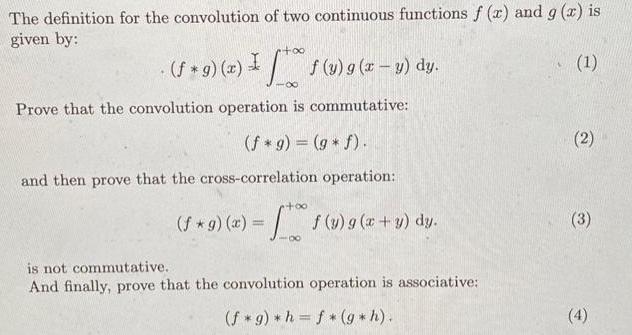Question
The definition for the convolution of two continuous functions f (x) and g(x) is given by: (1) - . (f*9) (x) f (y) 9

The definition for the convolution of two continuous functions f (x) and g(x) is given by: (1) - . (f*9) (x) f (y) 9 (x y) dy. I - Prove that the convolution operation is commutative: (f*g) = (g* f). and then prove that the cross-correlation operation: (f*g) (a) = f (y) g(x+y) dy. is not commutative. And finally, prove that the convolution operation is associative: (f*g) *h = f* (g* h). (2) (3) (4)
Step by Step Solution
3.39 Rating (155 Votes )
There are 3 Steps involved in it
Step: 1
Solution to the convolution and crosscorrelation operations Convolution The convolution of two continuous functionsfxandgxis defined as follows fgx integralinftyinfty fy gxy dy This can be interpreted ...
Get Instant Access to Expert-Tailored Solutions
See step-by-step solutions with expert insights and AI powered tools for academic success
Step: 2

Step: 3

Ace Your Homework with AI
Get the answers you need in no time with our AI-driven, step-by-step assistance
Get StartedRecommended Textbook for
College Algebra
Authors: Robert F Blitzer
7th Edition
013449492X, 9780134453262
Students also viewed these Programming questions
Question
Answered: 1 week ago
Question
Answered: 1 week ago
Question
Answered: 1 week ago
Question
Answered: 1 week ago
Question
Answered: 1 week ago
Question
Answered: 1 week ago
Question
Answered: 1 week ago
Question
Answered: 1 week ago
Question
Answered: 1 week ago
Question
Answered: 1 week ago
Question
Answered: 1 week ago
Question
Answered: 1 week ago
Question
Answered: 1 week ago
Question
Answered: 1 week ago
Question
Answered: 1 week ago
Question
Answered: 1 week ago
Question
Answered: 1 week ago
Question
Answered: 1 week ago
Question
Answered: 1 week ago
Question
Answered: 1 week ago
Question
Answered: 1 week ago
Question
Answered: 1 week ago
View Answer in SolutionInn App



